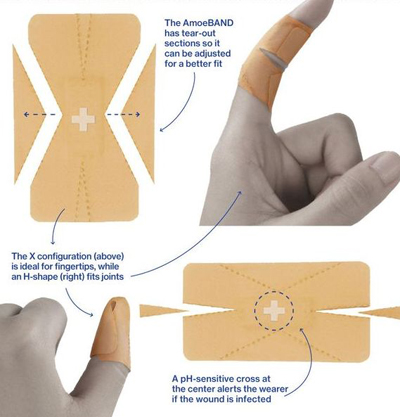The Bandage - Reinvented
for the 21st Century
A sterile bandage, also known as a sterile dressing,
is any material that is free from infectious matter and that is used to cover an
open wound or injury to help control bleeding and prevent additional
contamination from the environment. Some type of sterile bandage often is used
to restore the protection to the body temporarily by covering the break or tear
in the skin while it heals.
There is more than one type of sterile bandage;
adhesive bandages, medicated bandages, cohesive bandages and liquid bandages all
can be included as sterile dressings. The choice of which type to use generally
is dictated by the type and severity of the injury. For example, emergency
medical technicians (EMTs) and paramedics in the United States often use a
special type of sterile bandage known as an occlusive dressing. This is done in
order to form an airtight seal over an open wound to large veins in the neck,
the abdomen or the chest.
According the Bandage history
In 1920: Brand Adhesive Bandages make their
first appearance on the market. They are made by hand and are not a big hit.
They were three inches wide and eighteen inches long.
In 1938: Completely sterile bandages are
introduced
In 1958: Brand Adhesive Bandages are first
produced in sheer vinyl.
In 1963: Adhesive bandages go into space with
Mercury astronauts.
The conventional bandage does not cover all wounds
well. A cut on your finger is different than a cut on your thumb. Consumers have
to buy a box full of multiple shaped and sized bandages. University students in
Taiwan have come up with a design that features cutaways so the bandage can be
adjusted to fit the location of the wound. The name of which is AmoeBAND
which became a 2012 IDEA Award Finalist by innovating every possible aspect of
the bandage. The name comes from the shape-shifting amoeba.

The design revisions include:
Strategic cut-outs shape to fit fingers in
such a way that it is easy to bend them and not disrupt the bandage.
An intelligent dressing material allows you
to regularly check wounds from the outside, without upsetting the healing
process.”According to research, when an infection of a wound is detected, the pH
value is between 6.5 and 8.5. AmoeBAND’s indicator cross turns purple,
alerting the user needs to change it immediately.”
Since the bandage material used exudes a
leather-like feel, availability in different skin-tones helps it blend
in, without overly highlighting the injury.
The packaging has been redesigned to a matchbox
style and includes Braille instructions.
A pH-sensitive cross at the center alerts the wearer
if the wound is infected.
|